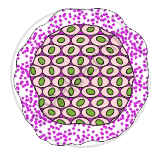Advertisements
Advertisements
प्रश्न
List any two modes of asexual reproduction in animals.Under which mode of reproduction is vegetative propagation placed and why?
उत्तर
The two modes of asexual reproduction in animals are:
(i) Binary fission
In binary fission, a single cell divides into halves. Some of the organisms that divide by binary fission are bacteria and Amoeba.

In Amoeba, cell division or splitting of cells can take place in any plane. Binary fission can occur in a particular axis. For example, Leishmania (a parasitic flagellated protozoan), which causes kala-azar in humans, divides longitudinally.
(ii) Multiple fission: In multiple fission, a single cell divides into many daughter cells simultaneously. Examples: Plasmodium and Amoeba

(iii) Budding
It involves formation of a new individual from a protrusion called a bud. It is very common in plants, yeasts and lower level animals, such as Hydra.
In Hydra, the cells divide rapidly at a specific site and develop as an outgrowth called a bud. The bud, while attached to the parent plant, develops into a small individual. When this individual becomes large enough, it detaches itself from the parent body to exist independently.

Vegetative propagation is a form of asexual reproduction. It is the ability of plants to produce new plants from the vegetative parts, such as leaves, stems and roots, under favourable conditions. This method is the means of reproduction of some seedless plant varieties such as banana, rose and jasmine. This method is also used in agriculture for the commercial production of some plants such as sugarcane, grapes and roses.
